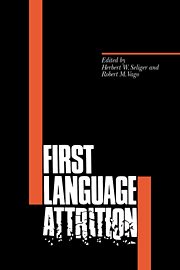Book contents
- Frontmatter
- Contents
- List of figures
- List of tables
- List of contributors
- Acknowledgment
- Part I Survey studies
- Part II Group studies
- Part III Case studies
- 12 Morphological disintegration and reconstruction in first language attrition
- 13 Assessing first language vulnerability to attrition
- 14 Compensatory strategies of child first language attrition
- 15 Language attrition, reduced redundancy, and creativity
- 16 Paradigmatic regularity in first language attrition
- Index
14 - Compensatory strategies of child first language attrition
Published online by Cambridge University Press: 14 January 2010
- Frontmatter
- Contents
- List of figures
- List of tables
- List of contributors
- Acknowledgment
- Part I Survey studies
- Part II Group studies
- Part III Case studies
- 12 Morphological disintegration and reconstruction in first language attrition
- 13 Assessing first language vulnerability to attrition
- 14 Compensatory strategies of child first language attrition
- 15 Language attrition, reduced redundancy, and creativity
- 16 Paradigmatic regularity in first language attrition
- Index
Summary
Introduction
A growing interest in the area of language loss or attrition has been seen in recent years (e.g. Lambert & Freed 1982; Seliger 1984). However, relatively little research has been devoted to the phenomenon of first language loss in young children. In this chapter, we describe the attrition of a young child's first language, focusing in particular on the question: How does the child first language attriter compensate for native language deficiencies? Our data will also be used to address a number of pertinent ancillary questions: (1) Does the use of certain compensatory strategies indicate that the child has a conscious awareness of language loss? (2) Are the compensatory strategies used by first and second language attriters culture and language bound?, and, especially, (3) Are the compensatory strategies used by the child first language attriter the same as those used by child and adult second language learners? If children are found to use the same compensatory strategies as adults, then this fact would suggest that the use of these strategies is not dependent upon advanced cognitive development. Further, if the same compensatory strategies are used in coping with language loss as with language acquisition, the implication is that the cause of incomplete linguistic knowledge (here, the process of acquisition versus attrition) is not a factor in selecting the strategies that are used to cope with it.
Compensatory strategies are described by Tarone (1981) as those strategies used by the second language speaker when he/she desires to communicate a particular meaning to a listener but believes there is a lack in his/her second language linguistic system.
- Type
- Chapter
- Information
- First Language Attrition , pp. 207 - 226Publisher: Cambridge University PressPrint publication year: 1991
- 26
- Cited by



